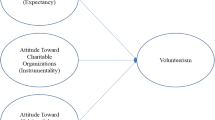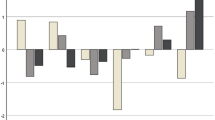Abstract
Using self-determination theory (SDT; Deci and Ryan 1985), we conducted a cross-sectional survey to test the relationship among competence, intrinsic motivation, job satisfaction, and intention to continue volunteering. A total of 180 Special Olympics volunteers from China participated in this study. The results showed that competence positively predicted intrinsic motivation and job satisfaction. Intrinsic motivation was a partial mediator for the relationship between competence and job satisfaction. Job satisfaction positively influenced intention and it acted as a full mediator in the relationship between intrinsic motivation and intention. It was concluded that SDT is a useful theoretical framework in understanding intention to continue volunteering. Theoretical and practical implications are provided.
Résumé
À l’aide de la théorie de l’autodétermination (TAD; Deci et Ryan, 1985), nous avons mené une enquête transversale en vue de tester la relation entre les compétences, la motivation intrinsèque, la satisfaction au travail et l’intention de continuer à faire du bénévolat. Un total de 180 bénévoles des Jeux Olympiques spéciaux, en Chine, ont participé à cette étude. Les résultats ont montré que les compétences prédisaient de manière positive la motivation intrinsèque et la satisfaction au travail. La motivation intrinsèque était en partie un facteur de relation entre les compétences et la satisfaction au travail. La satisfaction au travail influençait positivement l’intention et servait de facteur de relation entre la motivation intrinsèque et l’intention. Il est ressorti de l’enquête que la TAD était un cadre théorique utile pour comprendre l’intention de continuer à faire du bénévolat. Les implications théoriques et pratiques sont apportées.
Zusammenfassung
Wir führten unter Anwendung der Selbstbestimmungstheorie (Deci und Ryan 1985) eine Querschnittsbefragung durch, um die Beziehung zwischen Kompetenz, intrinsischer Motivation, Arbeitszufriedenheit und der Absicht zu einer weiteren ehrenamtlichen Tätigkeit zu untersuchen. Insgesamt 180 Personen aus China, die sich ehrenamtlich bei den Paralympischen Spielen engagierten, nahmen an dieser Studie teil. Die Ergebnisse zeigten, dass die Kompetenz zur intrinsischen Motivation und Arbeitszufriedenheit beiträgt. Die intrinsische Motivation war ein partieller Mediator für die Beziehung zwischen Kompetenz und Arbeitszufriedenheit. Die Arbeitszufriedenheit wirkte sich positiv auf die Absicht aus und agierte in der Beziehung zwischen intrinisischer Motivation und der Absicht als ein totaler Mediator. Man kam zu dem Schluss, dass die Selbstbestimmungstheorie ein nützliches theoretisches Rahmenwerk ist, um die Absicht zur weiteren ehrenamtlichen Tätigkeit zu verstehen. Theroretische und praktische Implikationen werden bereitgestellt.
Resumen
Utilizando la Teoría de la Autodeterminación (SDT, del inglés Self-Determination Theory; Deci y Ryan 1985), realizamos una encuesta transversal para poner a prueba la relación entre competencia, motivación intrínseca, satisfacción laboral e intención de seguir haciendo voluntariado. Un total de 180 voluntarios de las Olimpiadas Especiales de China participaron en el presente estudio. Los resultados mostraron que la competencia predecía de manera positiva la motivación intrínseca y la satisfacción laboral. La motivación intrínseca era un mediador parcial de la relación entre competencia y satisfacción laboral. La satisfacción laboral influía positivamente en la intención y actuaba como un mediador total en la relación entre la motivación intrínseca y la intención. Se concluyó que la SDT es un marco teórico útil en la comprensión de la intención para seguir haciendo voluntariado. Se proporcionan implicaciones teóricas y prácticas.
摘要
使用自我决定理论(SDT; Deci and Ryan 1985),我们进行了跨领域调查,从而测试能力、内在动机、工作满意度和继续参加自愿活动意愿之间的关系。总共有180位来自**的特殊奥运会志愿者参加了本次调查。内在动机是能力和工作满意度之间关系的部分动力。工作满意度积极影响意愿,同时作为内在动机和意愿之间关系的完整动力。结论是,对于了解继续参加自愿活动的意愿,SDT是一个有用的理论框架。提供了理论和实践含义。
ملخص
بإستخدام نظرية تقرير المصير(1985 Ryan وSDT; Deci)، أجرينا إستطلاع رأي فحص للمتغيرات لإختبار العلاقة بين الكفاءة٬ الدوافع الذاتية، الرضا الوظيفي، والنية لمواصلة العمل التطوعي. شارك ما مجموعه 180 من المتطوعين من أولمبياد خاص من الصين في هذه الدراسة. أظهرت النتائج أن الكفاءة تتوقع إيجابيا˝ الدوافع الذاتية والرضا الوظيفي. كانت الدوافع الذاتية وسيط جزئي للعلاقة بين الكفاءة والرضا الوظيفي. أثرالرضا الوظيفي بشكل إيجابي على النية وإنه تصرف كوسيط كامل في العلاقة بين الدوافع الذاتية والنية. نستنتج أن تقرير المصير(SDT) هو الإطار النظري المفيد في فهم النية لمواصلة العمل التطوعي. تم تقديم آثار نظرية وعملية.

Similar content being viewed by others
References
Ajzen, I. (1991). The theory of planned behavior. Organizational Behavior and Human Decision Processes, 50, 179–211. doi:10.1016/0749-5978(91)90020-T.
Arbuckle, J. L. (2011). IBM SPSS AMOS 20 user’s guide. Armonk: IBM Corporation.
Baran, F., Özer, D., Aktop, A., Nalbant, S., Ağlamış, E., Barak, S., & Hutzler, Y. (2013). The effects of a Special Olympics Unified Sports soccer training program on anthropometry, physical fitness and skilled performance in Special Olympics soccer athletes and non-disabled partners. Research in Developmental Disabilities, 34, 695–709. doi:10.1016/j.ridd.2012.10.003.
Barraza, J. A. (2011). Positive emotional expectations predict volunteer outcomes for new volunteers. Motivation and Emotion, 35, 211–219. doi:10.1007/s11031-011-9210-4.
Bidee, J., Vantilborgh, T., Pepermans, R., Huybrechts, G., Willems, J., Jegers, M., & Hofmans, J. (2013). Autonomous motivation stimulates volunteers’ work effort: A self-determination theory approach to volunteerism. VOLUNTAS: International Journal of Voluntary and Nonprofit Organizations, 24, 32–47. doi:10.1007/s11266-012-9269-x.
Bollen, K. A. (1989). Structural equations with latent variables. New York: Wiley.
Brislin, R. W. (1980). Translation and content analysis of oral and written materials. In H. C. Triandis & G. W. Berry (Eds.), Handbook of cross-cultural psychology (pp. 398–444). Boston: Allyn & Bacon.
Brooks, A., Farquharson, L., Burnell, K., & Charlesworth, G. (2014). A narrative enquiry of experienced family carers of people with dementia volunteering in a carer supporter programme. Journal of Community & Applied Social Psychology,. doi:10.1002/casp.2188.
Brown, T. A. (2006). Confirmatory factor analysis for applied research. New York: The Guilford Press.
Byrne, B. M. (2006). Structural equation modeling with EQS: Basic concepts, applications, and programming (2nd ed.). New Jersey: Laurence Erlbaum Associates.
Chen, S., Li, C., & Wu, Y. (2011). Development of Special Olympics in China: Competition, inclusion, research and future. Asian Journal of Exercise and Sports Science, 8, 30–38.
Chursov, A. (2007). The campaign for Special Olympics: Celebrating growth. Retrieved Oct 1, 2009. http://www.specialolympics.org.
Cohen, J. (1988). Statistical power analysis for the behavioral sciences. Hillsdale, NJ: Lawrence Erlbaum Associates.
Deci, E. L., & Ryan, R. M. (1985). Intrinsic motivation and self-determination in human behavior. New York, NY: Plenum Press.
Deci, E. L., & Ryan, R. M. (2000). The “what” and “why” of goal pursuits: Human needs and the self-determination of behavior. Psychological Inquiry, 11, 227–268. doi:10.1207/S15327965PLI1104_01.
Gagné, M., Forest, J., Gilbert, M. H., Aubé, C., Morin, E., & Malorni, A. (2010). The motivation at work scale: Validation evidence in two languages. Educational and Psychological Measurement, 70, 628–646. doi:10.1177/0013164409355698.
Ghose, T., & Kassam, M. (2014). Motivations to volunteer among college students in India. VOLUNTAS: International Journal of Voluntary and Nonprofit Organizations, 25, 28–45. doi:10.1007/s11266-012-9327-4.
Haivas, S., Hofmans, J., & Pepermans, R. (2013). Volunteer engagement and intention to quit from a self-determination theory perspective. Journal of Applied Social Psychology, 43, 1869–1880. doi:10.1111/jasp.12149.
Hall, D., Hall, I., Cameron, A., & Green, P. (2004). Student volunteering and the active community: Issues and opportunities for teaching and learning in sociology. Learning and Teaching in the Social Sciences, 1, 33–50. doi:10.1386/ltss.1.1.33/0.
Hu, L., & Bentler, P. M. (1999). Cutoff criteria for fit indexes in covariance structure analysis: Conventional criteria versus new alternatives. Structural Equation Modeling: A Multidisciplinary Journal, 6, 1–55. doi:10.1080/10705519909540118.
Hutzler, Y., Oz, M., & Barak, S. (2013). Goal perspectives and sport participation motivation of Special Olympians and typically develo** athletes. Research in Developmental Disabilities, 34, 2149–2160. doi:10.1016/j.ridd.2013.03.019.
Jacobsen, S. K., Carlton, J. S., & Monroe, M. C. (2012). Motivation and satisfaction of volunteers at a Florida natural resource agency. Journal of Park & Recreation Administration, 30, 51–67.
Khoo, S., & Engelhorn, R. (2011). Volunteer motivations at a National Special Olympics event. Adapted Physical Activity Quarterly, 28, 27–39.
Kidder, L. H., & Judd, C. M. (1986). Research methods in social relations (5th ed.). New York, NY: Holt, Rinehart & Winston.
Kim, M., Chelladurai, P., & Trail, G. T. (2007). A model of volunteer retention in youth sport. Journal of Sport Management, 21, 151–171.
Kline, R. B. (2005). Principles and practice of structural equation modeling (2nd ed.). New York, NY: The Guilford Press.
Lai, M. H., Ren, M. Y., Wu, A., & Hung, E. P. (2013). Motivation as mediator between national identity and intention to volunteer. Journal of Community & Applied Social Psychology, 23, 128–142. doi:10.1002/casp.2108.
Li, C., & Wang, C. K. J. (2013). Effect of exposure to Special Olympic Games on attitudes of volunteers towards inclusion of people with intellectual disabilities. Journal of Applied Research in Intellectual Disabilities, 26, 515–521. doi:10.1111/jar.12053.
Lu, W. P. (2004). Important role of Special Olympics volunteers. In Paper presented at The First National Adapted Physical Education and Sports Conference, Nan**g, China.
MacLean, J., & Hamm, S. (2007). Motivation, commitment, and intentions of volunteers at a large Canadian sporting event. Leisure, 31, 523–556. doi:10.1080/14927713.2007.9651394.
Marsh, H. W., Hau, K.-T., & Wen, Z. (2004). In search of golden rules: Comment on hypothesis-testing approaches to setting cutoff values for fit indexes and dangers in overgeneralizing Hu and Bentler’s (1999) findings. Structural Equation Modeling: A Multidisciplinary Journal, 11, 320–341.
Millette, V., & Gagné, M. (2008). Designing volunteers’ tasks to maximize motivation, satisfaction and performance: The impact of job characteristics on volunteer engagement. Motivation and Emotion, 32, 11–22. doi:10.1007/s11031-007-9079-4.
Mitchell, T. R., Holtom, B. C., Lee, T. W., Sablynski, C. J., & Erez, M. (2001). Why people stay: Using job embeddedness to predict voluntary turnover. Academy of Management Journal, 44, 1102–1121.
Netting, F. E., O’Connor, M. K., Thomas, M. L., & Yancey, G. (2005). Mixing and phasing of roles among volunteers, staff, and participants in faith-based programs. Nonprofit and Voluntary Sector Quarterly, 34, 179–205. doi:10.1177/0899764005275204.
Podsakoff, P. M., MacKenzie, S. B., Lee, J. Y., & Podsakoff, N. P. (2003). Common method biases in behavioral research: A critical review of the literature and recommended remedies. Journal of Applied Psychology, 88, 879–903. doi:10.1037/0021-9010.88.5.879.
Preacher, K. J., & Hayes, A. F. (2008). Asymptotic and resampling strategies for assessing and comparing direct effects in multiple mediator models. Behavior Research Methods, 4, 879–891. doi:10.3758/BRM.40.3.879.
Ridge, R. D., & Montoya, J. A. (2013). Favorable contact during volunteer service: Reducing prejudice toward Mexicans in the American southwest. Journal of Community & Applied Social Psychology, 23, 466–480. doi:10.1002/casp.2144.
Ryan, R. M., & Deci, E. L. (2000). Self-determination theory and the facilitation of intrinsic motivation, social development, and well-being. American Psychologist, 55, 68–78. doi:10.1037/0003-066X.55.1.68.
Silverberg, K., Marshall, E., & Ellis, G. (2001). Measuring job satisfaction of volunteers in public parks and recreation. Journal of Park and Recreation Administration, 19, 79–92.
Special Olympics. (2009). Special Olympics. Retrieved Oct 1, 2009. from http://www.specialolympics.org/.
Vallerand, R. J. (2007). A hierarchical model of intrinsic and extrinsic motivation for sport and physical activity. In M. S. Hagger & N. L. D. Chatzisarantis (Eds.), Self-determination theory in exercise and sport (pp. 255–279). Champaign, IL: Human Kinetics.
Wang, C., & Wu, X. (2014). Volunteers’ motivation, satisfaction, and management in large-scale events: An empirical test from the 2010 Shanghai World Expo. VOLUNTAS: International Journal of Voluntary and Nonprofit Organizations, 25, 754–771. doi:10.1007/s11266-013-9350-0.
Williams, G. C., Freedman, Z. R., & Deci, E. L. (1998). Supporting autonomy to motivate glucose control in patients with diabetes. Diabetes Care, 21, 1644–1651. doi:10.2337/diacare.21.10.1644.
Wilson, J. (2000). Volunteering. Annual Review of Sociology, 26, 215–240. doi:10.1146/annurev.soc.26.1.215.
Acknowledgments
This study was supported by the China Disabled Persons’ Federation (Number 2014 & ZC006) and the Federation of The Disabled in Fuzhou (Number HN-447).
Author information
Authors and Affiliations
Corresponding author
Appendix
Appendix
See Table 2.
Rights and permissions
About this article
Cite this article
Wu, Y., Li, C. & Khoo, S. Predicting Future Volunteering Intentions Through a Self-determination Theory Perspective. Voluntas 27, 1266–1279 (2016). https://doi.org/10.1007/s11266-015-9570-6
Published:
Issue Date:
DOI: https://doi.org/10.1007/s11266-015-9570-6




